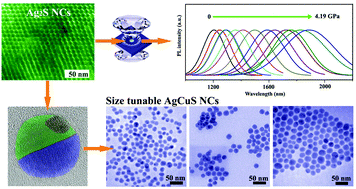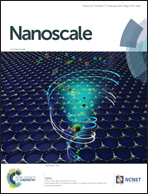Pressure induced photoluminescence modulation in a wide range and synthesis of monodispersed ternary AgCuS nanocrystal based on Ag2S nanocrystals†
Abstract
Binary Ag2S nanocrystals (NCs) have many potential optical applications because of their low toxicity, narrow direct band gaps and near-infrared photoluminescence (PL) with high emission efficiency. However, due to its small exciton Bohr radius (2.2 nm), the PL spectra of Ag2S NCs can only be modulated below ∼1200 nm with increasing particle size. Meanwhile, ternary silver copper chalcogenides (AgCuX, X = S, Se) have also attracted increased attention in recent years. Temperature-dependent structural phase transformation leads electrical transport to exhibit fascinating transitions between p and n type conduction, which makes AgCuS and AgCuSe ideal materials for diode or transistor devices. Nevertheless, the traditional method to synthesize these materials is mainly through melting the mixture of Ag, Cu and S/Se powder under extremely high reaction temperatures (973–1373 K) and long reaction time, forming a bulk product. Therefore, the synthesis of high quality monodispersed and size-tunable AgCuS or AgCuSe NCs is still a challenge. To address these issues, in this paper, we report using Ag2S NCs as a template, a method to synthesize monodispersed and size-tunable β-AgCuS NCs via ion exchange and diffusion processes. Similarly, monodispersed β-AgCuSe NCs were also synthesized by this simple and reproducible strategy. This synthetic method opens new avenues for investigating the size-, morphology- and temperature-dependent phase transitions of these ternary AgCuS and AgCuSe materials. Thus, the corresponding electrical transport between p and n type conduction can be studied in the future. Furthermore, we systematically investigated the pressure-dependent PL properties and band gap modulation of monodispersed Ag2S NCs using in situ high pressure PL and absorption spectroscopy. We found that the PL peak of 6.0 nm for Ag2S NCs could be easily adjusted from ∼1200 to 1900 nm with increasing pressure from 0 to 5.1 GPa, which greatly extends the wavelength range of the PL peak beyond that of other approaches.



 Please wait while we load your content...
Please wait while we load your content...